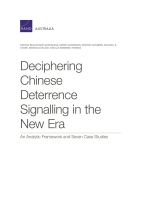by Nathan Beauchamp-Mustafaga, Derek Grossman, Kristen Gunness
In Xi Jinping's 'new era', Chinese ambitions are increasingly global, its behaviour is increasingly aggressive, and its military is increasingly a leading edge of national power. China is also changing its approach to deterrence signalling in this 'new era' as it leverages growing military capabilities and the availability of new communication channels.
This report is intended to help analysts and policymakers in Australia, the United States, and other countries better decipher Chinese deterrence signalling in this 'new era'. For China, deterrence (威慑, weishe) is not simply the objective of forestalling an adversary's undesired action, as in Western thinking—it also includes aspects of compellence, meaning that China often uses its military to coerce other countries to take actions Beijing desires. This report provides an analytic framework to interpret Chinese deterrence signalling and explores seven case studies of recent Chinese deterrence behaviour to illuminate what has stayed the same and what has changed in Chinese peacetime and crisis deterrence signalling.
Overall, although China's capabilities and communication channels have changed, its fundamental approach to military deterrence signalling as a form of political coercion has not changed. Rather, Beijing is employing military deterrence signalling more frequently and in bolder ways to achieve its grander objectives. This means that analysts are likely to face an ever-greater task of deciphering this ever-expanding milieu to ensure that policymakers can separate the signal from the noise and respond to what matters (and look past what does not) to better manage future crises.
Key Findings
China has shown that it takes a comprehensive approach to deterrence and deterrence signalling, one that is based on the use of multiple instruments of national power—not only military strength but also economic leverage, diplomatic influence, and information manipulation
Although China's capabilities and communication channels have changed, its fundamental approach to military deterrence signalling as a form of political coercion has not.
China is using military deterrence signalling more frequently and more boldly than before, requiring expertise to distinguish the signal from the noise and respond to what matters.
A comprehensive framework of accurate and nuanced interpretation of Chinese deterrence signalling is crucial for policymakers
It is important to understand the strategic context of any specific episode in which China employs deterrence signalling: China's security interests, its threat perceptions, and its past behaviour.
It is crucial to identify the key content that is being communicated: What is China saying and doing?
It is important to identify the key audience or audiences China is attempting to reach and what these choices reveal about its deterrence objectives.
There is a strict hierarchy of authoritativeness within the Party-state system, which is central to assessing signals. Social media and unofficial voices often contribute more noise than signal.
The scope of Chinese signalling is an important indicator of Beijing's willingness to consider the use of force.
Recommendations
The Australian, U.S., and regional governments should consider in advance what signals China might send in a future crisis and how it will communicate them. This includes not just the most likely signals but also ones that might get lost in the noise or that are difficult to confirm.
The Australian government should consider structured expert roundtables, table-top exercises, or wargames to explore what signals China might send, how they would be interpreted in Canberra, how Australia would respond, and the implications for crisis management.
There should be further research into the ways China plans to use its space and cyber capabilities for deterrence signalling and how it would likely interpret and react to signals sent by others in response. Research should also seek to better understand how China coordinates and uses comprehensive national power for deterrence beyond military means.
Australia should engage the United States and regional partners on how they understand Chinese deterrence signalling. Beijing's tailored approach to deterrence against target countries varies, and countries have varying means to collect and interpret signals. Australia, the United States, and regional countries should confer to arrive at a common understanding of China's signalling.
Australia should pursue appropriate dialogue with China on deterrence signalling. Although hardening strategic competition makes this difficult, the growing risk of inadvertent military crises requires it.

No comments:
Post a Comment